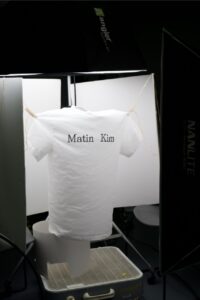A white T-shirt is often seen as the most classic basic garment. But how “basic” is your basic white T-shirt? In my project, I explored the construction of “basic white tees” from various brands, examining them from an inside perspective. By capturing the volumetric surface area of the insides, I hoped to bring out the subtle uniqueness of these shirts from the differences in linings and looming methods to the placement of tags and the varying hues of “white.”
Approach
Similarly to the studies of the insides of things,

I used a 360-degree camera to get a fisheye perspective of the shirts and edited them to upload into a spherical viewer. This approach allowed an immersive navigable experience, giving you a feel of what it’s like to be inside these shirts and appreciate the details that set them apart.
Process
Setup: 1 Softbox, 1 Box Fan, 1 Chair dolly platform under the fan to allow airflow, 2 Foldable Panel Reflectors, 1 Rectangular Lightbox for more even light distribution, 2 chairs to set them up, some wooden clothespins, and string.


Mi Shpere 360 Camera Test Shot
After a few adjustments, I made an expandable funnel with a cutout to direct airflow and allow access to manipulate the shirts.


360 Camera POV
When the photos were taken I cropped and edited them in Photoshop.
Footages taken of UNIQLO, Levi’s, ProClub, Hurley, Matin Kim, and Mango.
I uploaded the edited images to a JavaScript-based tool that renders and allows interaction with 360° panoramic images. This enabled navigation through the insides of the shirts.

Finally, Leo helped me create an HTML website using GitHub Pages to host the images, allowing for simultaneous navigation of multiple shirts.
Draft using localhost portal

Browser website using GitHub Pages

Summary
By focusing on the inside of the garments, I highlighted the structural details that are often overlooked. The materials and construction techniques—whether from mass-produced or higher-end garments—show interesting contrasts. While expensive clothes may have finer finishes, the actual differences aren’t always as big as expected. It’s in the smaller details, like stitching and tag placement, where the craftsmanship, or lack of it, becomes most apparent.
Reflection
I enjoyed the literal process of “configuring the shirt inside out.” It was particularly interesting to examine the side seams and how some didn’t have them because it used a tubular looming method. It also expanded into narratives of the owners of the shirts (my friend in industrial design vs my friend in graphic design).
Something I would’ve done differently in my process is to use a DSLR with a fisheye lens because I noticed a lot of details were getting lost with the particular model of the 360 camera I used.
In the future, I think it would be cool to expand this project into a shopping website for white shirts or certain kinds of garments where the only visual information you will get is the inside of the shirts rather than the external appearance or branding. This concept challenges traditional consumer habits, pushing back against superficial buying trends and the impact of mass production. It encourages consumers to think more critically about the construction and quality of the items they purchase.
 .
. 